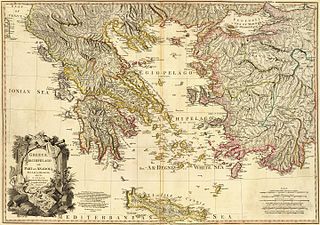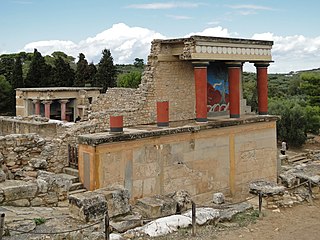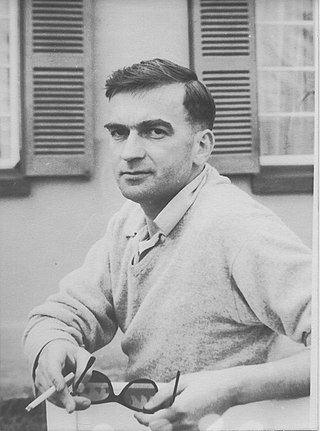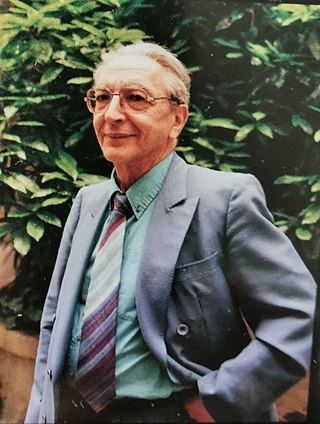Related Research Articles

Aegean civilization is a general term for the Bronze Age civilizations of Greece around the Aegean Sea. There are three distinct but communicating and interacting geographic regions covered by this term: Crete, the Cyclades and the Greek mainland. Crete is associated with the Minoan civilization from the Early Bronze Age. The Cycladic civilization converges with the mainland during the Early Helladic ("Minyan") period and with Crete in the Middle Minoan period. From c. 1450 BC, the Greek Mycenaean civilization spreads to Crete, probably by military conquest. The earlier Aegean farming populations of Neolithic Greece brought agriculture westward into Europe before 5,000 BCE.

Knossos is a Bronze Age archaeological site in Crete. The site was a major center of the Minoan civilization and is known for its association with the Greek myth of Theseus and the minotaur. It is located on the outskirts of Heraklion, and remains a popular tourist destination. Knossos is considered by many to be the oldest city in Europe.

Beauvais is a town and commune in northern France, and prefecture of the Oise département, in the Hauts-de-France region, 75 kilometres north of Paris.
Jean-Paul Crespelle was a journalist and author. He was born in Nogent-sur-Marne, Île-de-France, France.
The Proto-Ionians are the hypothetical earliest speakers of the Ionic dialects of Ancient Greek, chiefly in the works of Jean Faucounau. The relation of Ionic to the other Greek dialects has been subject to some debate. It is mostly grouped with Arcadocypriot as opposed to Doric, reflecting two waves of migration into Greece following the Proto-Greek period, but sometimes also as separate from Arcadocypriot on equal footing with Doric, suggesting three distinct waves of migration.
Jacques Chastenet de Castaing was a French journalist, historian and diplomat.

Michel Pastoureau is a French professor of medieval history and an expert in Western symbology.
Robert Flacelière was a scholar of Classical Greek. He was educated at the Collège Sainte-Barbe, the Lycée Henri IV and the École Normale Supérieure. From 1925 to 1930, he was a member of the French School in Athens and from 1932-1948 a Professor of the Faculty of Letters at University of Lyon. He was then appointed to the Chair of Greek Language and Literature at the University of Paris, a post he held until 1963 when he was appointed Director of the École Normale Supérieure.
Pierre Grimal was a French historian, classicist and Latinist. Fascinated by the Greek and Roman civilizations, he did much to promote the cultural inheritance of the classical world, both among specialists and the general public.

Gilbert Martineau was a French naval officer, author of books on Napoleon and his family, honorary consul, and curator 1956-1987 of the French properties on St Helena, where Napoleon had been in exile.
Jacques Gernet was an eminent French sinologist of the second half of the 20th century. His best-known work is The Chinese Civilization, a 900-page summary of Chinese history and civilization which has been translated into many languages.

Louis-Frédéric Nussbaum, also known as Louis Frédéric or Louis-Frédéric (1923–1996), was a French scholar, art historian, writer and editor. He was a specialist in the cultures of Asia, especially India and Japan.
Claude Dulong-Sainteny or Marguerite-Claude Badalo-Dulong or Claude Dulong was a French historian.

Eugène Marsan (1882–1936) was a French author and literary critic. He won the Prix Vitet from the Académie française in 1936.
Jean Robiquet was a French art historian, art critic and curator. He was also a playwright and opérettes librettist known under the pseudonym Jean Roby.

Yves-Marie Bercé, is a French historian known for his work on popular revolts of the modern era. He is a member of the Institut de France.
Colette Picard was a French archaeologist and historian. As curator of the archaeological site of Carthage, she led excavations on the hill of Byrsa in 1947.
Jacques Heurgon was a French university, normalian, Etruscan scholar and Latinist, professor of Latin language and literature at the Sorbonne. Married to Anne Heurgon-Desjardins, founder in 1952, of the Centre culturel international de Cerisy-la-Salle, he was the father of Marc Heurgon, politician and historian, Catherine Peyrou and Edith Heurgon who continued the "Colloques of Cerisy".

Aimé Vincent Perpillou was a French geographer.
Émile Magne was a French writer, critic, historian of literature and art.
References
- ↑ Who's Who in France
- ↑ Paul Faure, by Florence Gaignerot-Driessen
- ↑ P. Faure (1984), "Du Caractère indo-européen de la langue écrite en Crète à l'âge du bronze moyen." Études Indo-Européennes 8: 1-23.